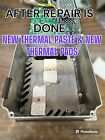sr1200
Well-known member
I have an amp that has blown a mosfet. It looks as though this has been replaced before and from what im finding on line about this particular speaker/amp, its a common issue. The current mosfet is a 20N60 600v breakdown voltage 20 amp drain current.
If I were to put a mosfet that had a bit more current drain on it, would that help at all or is there some other spec that I should look for to perhaps give this a little more longevity?
TIA
If I were to put a mosfet that had a bit more current drain on it, would that help at all or is there some other spec that I should look for to perhaps give this a little more longevity?
TIA



